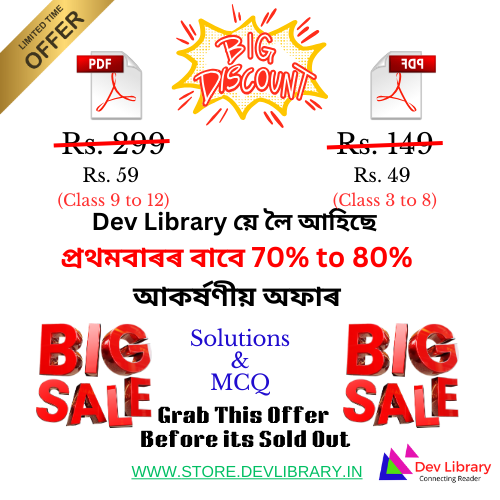SEBA Class 9 An Introduction to Commerce Chapter 3 Present Modes of Business Solutions in English Medium to each chapter is provided in the list so that you can easily browse throughout different chapters SEBA Class 9 An Introduction to Commerce Chapter 3 Present Modes of Business Question Answer, SEBA Class 9 Elective An Introduction to Commerce Notes in English Medium and select need one.
SEBA Class 9 An Introduction to Commerce Chapter 3 Present Modes of Business
Also, you can read the SCERT book online in these sections Solutions by Expert Teachers as per SEBA (CBSE) Book guidelines. SEBA Class 9 An Introduction to Commerce Chapter 3 Present Modes of Business Notes. These solutions are part of SCERT All Subject Solutions. Here we have given Elective An Introduction to Commerce Class 9 SEBA Solutions for All Chapters, You can practice these here.
Present Modes of Business
Chapter – 3
| UNIT – I BUSINESS STUDIES |
| Questions |
1. What is e-Commerce?
Ans: e-Commerce is an electronic system of dealing in all the commercial activities which can be done through the medium of Internet. These commercial activities include receiving information about the goods, placing an order, receiving delivery, making payment, etc.
2. Write the meaning of e-Business. Write the relationship between e-Commerce and e-Business.
Ans: e-Business refers to the conduct of industrial and commercial activities through computer networks or the internet. It involves a wide range of business functions, including production, marketing, sales, customer service, and internal processes, all carried out digitally. In short, e-Business encompasses all the business activities that are performed online.
e-Commerce refers specifically to the buying and selling of goods and services over the internet, focusing on transactions like purchases, payments, and order fulfillment. e-Business, on the other hand, is a broader concept that includes e-Commerce as one of its components.
3. What are the scopes of e-Business?
Ans: The scopes of e-Business are mentioned below:
(i) B2B Commerce (Business-to-Business Commerce).
(ii) B2C Commerce (Business-to-Customer Commerce).
(iii) Intra-B Commerce (Within Business Commerce).
(iv) C2C Commerce (Customer-to-Customer Commerce).
4. Distinguish between Traditional Business and e-Business.
Ans: Difference between Traditional Business and e-Business.
| S.No | Basic | Traditional Business | E-Business |
| 1 | Formation | Difficult | Easy |
| 2 | Physical Presence | Necessary | Not Required |
| 3 | Cost of setting up | More | Less |
| 4 | Dealing time | More | Less time. |
| 5 | Length of business cycle | Longer, because sequential among various business processes. | Less, transaction &Settled immediately on the Internet. |
| 6 | Opportunity for inter- personal | More | Less |
| 7 | Global Reach | Less | More |
| 8 | Government patronage | Less | More, because of giving priority to IT Sector. |
5. What are the benefits of e-Business in context to present scenario?
Ans: The benefits of e-Business in context to present scenario are mentioned below:
(i) World-Wide Reach: Those businessmen, who linked with e-Business, get world-wide recognition. This gives them a wide market around the world. New customers come in contact with them.
(ii) Shortening the Supply Chain: Since the e-Business came into existence, the middle men have started disappearing. This has resulted in the shrinking of the supply chain.
(iii) Easy Distribution: Many types of information and services can be received on the computer through the medium of e-Business. This has simplified the distribution system and has also made it less costly.
(iv) Quick Solutions: Internet is the basis of e-Business. Through the medium of the Internet the consumers and other businessmen can remove their doubts quickly.
6. Write the different methods of Online Payment.
Ans: The different method of online payments are mentioned below:
(a) Cash on Delivery (COD): It is a process of making any payment. After placing the order online, payments can be made in cash on the physical delivery of the Goods.
(b) Cheque: The vendor may pick up the cheque and deliver the goods to the door of the customer on the realization of the cheque.
(c) Net Banking Transfer: The buyer can make the payments for goods bought by transferring the payments from his account by using banking facility provided by bank with user id and password through which he is able to transfer the funds.
(d) Credit Card or Debit Card: Popularly known as plastic money, such cards are being widely used all over the world. On estimation around 95% of the online transactions are conducted with the help of credit card.
7. Write the types of safety and security issues relate to e-Business.
Ans: Safety and security issues over the internet in e-Transaction can be classified into following types of risks:
(a) Transaction Risks.
(b) Data Storage Risks.
(c) Transmission Risks.
(d) Intellectual Property and Privacy Risks.
8. Describe the resources required for e-Business.
Ans: The resources required for e-Business are mentioned below:
(i) Computer Hardware: For conducting electronic business, one needs to have good quality hardware consisting of monitor, CPU, key board, UPS loaded with required operating system and softwares required.
(ii) Technical and Qualified Staff: The computer staff is needed who must have sound knowledge of the computer world, holds degree or diploma in the required field with past experience to handle the online transactions independently.
(iii) Well Designed Official Website: Company must get its official website prepared from an experienced/well known website making company. Such a website must be complete in itself, should contain vision and mission of the company, history, official address, e-mail id, types of products, financial information, audio and visual presentations, notice and circulars and much more so that any outsider can get the desired information from the website.
(iv) Internet Connections: To connect with the rest of the world over the web, one needs to have a good Internet connection. It may be broadband connection, wireless connection, data card etc.

Hi! my Name is Parimal Roy. I have completed my Bachelor’s degree in Philosophy (B.A.) from Silapathar General College. Currently, I am working as an HR Manager at Dev Library. It is a website that provides study materials for students from Class 3 to 12, including SCERT and NCERT notes. It also offers resources for BA, B.Com, B.Sc, and Computer Science, along with postgraduate notes. Besides study materials, the website has novels, eBooks, health and finance articles, biographies, quotes, and more.



